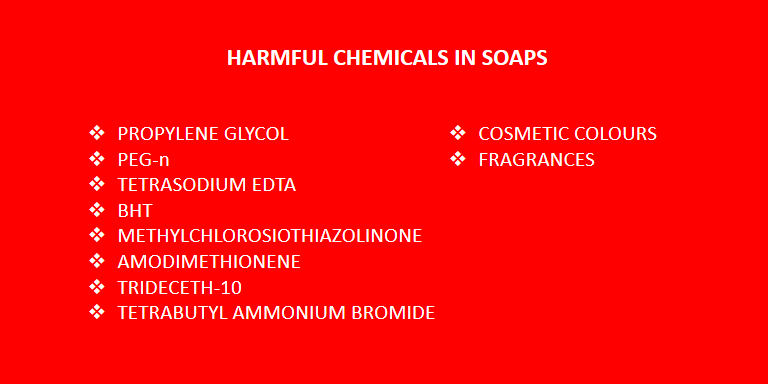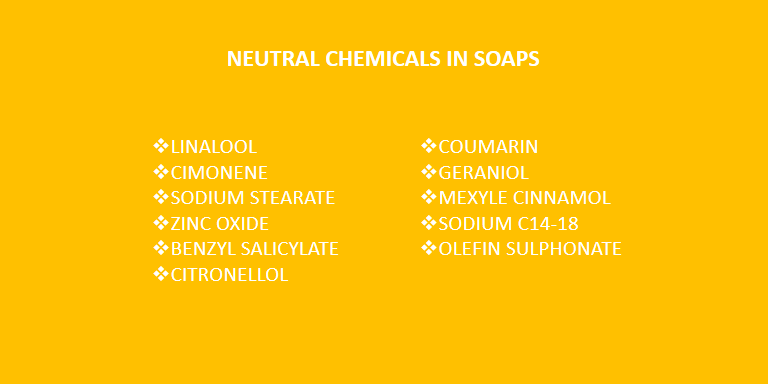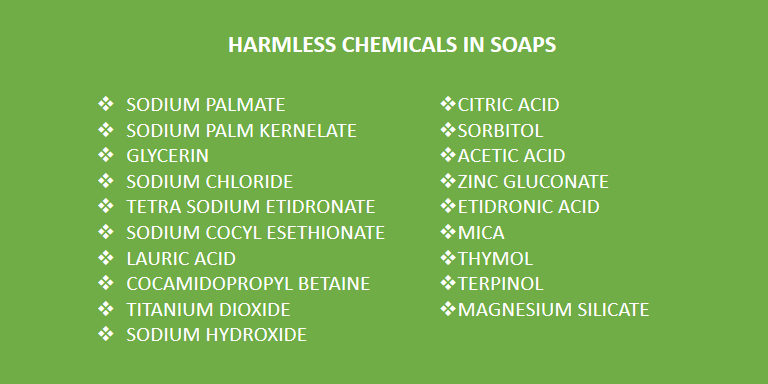Which soap have you been using? Lux, Cinthol, Dove or Pears?
Most of the soaps available in the market have so many toxic chemicals that a common man is unaware of.
From strong Detergents to harmful Alcohols to Petroleum products to pesticides, soaps have it all.
Soap is something that we apply to our body on a daily basis.
And when we use a soap which has many harmful chemicals over a period of time they seep into the bloodstreams through the pores in our body and damages from within.
The worst part is that we don’t even know that we are unintentionally harming our body on a daily basis.
Unfortunately, the soaps which we have been trusting since childhood have the maximum number of toxic chemicals.
I was so shocked during the research on soaps, I do have to change the bathing bar which I had been using all my life.
So keep reading as you too might want to though the bathing bar lying after you read this blog.
Let’s get started.
To write this article, I have thoroughly gone through each and every ingredient in almost all the soaps that were available in the Indian market.
Out of those I have picked up 20 most commonly soaps used in Indian homes.
I agree that not all chemicals are bad, but believe me, almost every soap that I checked had some of the other toxic chemicals in them and what I’m going to reveal here. So stay tuned.
We will not go through each and every ingredient used in soaps, here are some of the most common ones.


Most of the soaps have cosmetic colours and unfortunately, these colours score the highest mark on the toxic scale.
Fragrance in soaps may have more than 200 chemicals. Companies don’t have to disclose the composition of the fragrance under the umbrella of trade secrets.
Soaps in 5 Different Categories
I have divided these 20 soaps into 5 categories on the basis of the number of toxic chemicals in them.
Dettol, Pears, Fiama, Park Avenue, Vivel, Lux, Lifebuoy

Category no. 1 is that on the soaps which have the highest number of chemicals in them.
Dettol, Pears, Fiama, park avenue, Vivel, lux, lifebuoy have around 8 to 10 toxic chemicals in them.
These, in my opinion, are the worst of the kind. They have cosmetic colours, strong fragrances, and almost all the other harmful chemicals that we have seen.
Hamam, Rexona, Liril, Cinthol

Category no. 2 includes soaps like Hamam, Rexona, Liril, Cinthol which are better than the previous category but still have around 5 to 6 chemicals in them.
They too have synthetic colours, fragrances and harmful ingredients.
Santoor, Mysore Sandal, Chandrika Ayurvedic, Margo, Himalaya, Dove, Medimix

In Category number 3 are soaps like Santoors, Mysore sandal soap, Chandrika ayurvedic soap, Margo, Himalaya, Dove, Medimix etc.
These are much better than the previous two categories. They have just 2 to 3 toxic chemicals in them mainly colours and fragrances.
Liver Ayush Therapy and Biotique

Category no. 4 is one of its kind, they include liver Ayush therapy soap and Biotique soaps. These soaps are marketed as non-cosmetic therapeutic products.
However, if we see their ingredients they don’t even mention the complete list of ingredients.
Only 10 to 20% of the ingredients are mentioned, rest are covered under the umbrella of soap base which could be made of anything.
When I tried to reach out to any of these companies through different mediums, I did not get any satisfactory answer.
Patanjali’s Multani Mitti bar

Last but surely not the least is category number 5 which is backed by Patanjali’s Multani Mitti bar, which in my opinion is the best soaps in the market.
It has no harmful chemicals, no artificial fragrances and not even colours.
Although some other soaps by Patanjali do have synthetic colours and a few harmful chemicals in them.
So you can clearly see that almost every soap in the market has some of the chemicals which are not good for the body.
Why Harmful chemicals?
Now two questions arrive here,
Why are such ingredients added?
Why are such ingredients allowed?
I understand that it is very difficult to go through each and every ingredient when we go out to buy soap.
So let me give you three very basic tips, which I have learnt through the intensive research on soaps.
Tips For Buying Soaps
Too Many Ingredients? Avoid That Soap
Firstly avoid soaps which have too many ingredients. If you find a long list of ingredients where most of them are hard to pronounce, don’t buy that soap.
Fancier The Soap, Worse Would it Be
The fancier the soap in its appearance, the worst would it be for your health. Soaps like Park Avenue, Fiama devils, Lux prove my point.
Oils, Leaf Extracts, Herbs present, That means Good

Thirdly roughly go through the ingredients, if it has many oil base ingredients, leaf extracts and other herbal ingredients that soap is mostly liked to be a good choice.
Summary
| Category | Soaps | Recommended or Not | Why? |
| Dettol, Pears, Fiama, park avenue, Vivel, Lux, Lifebuoy | No | 8-10 toxic chemicals, colours, strong fragrances & almost all the other harmful chemicals discussed above. | |
| 2. | Hamam, Rexona, Liril, Cinthol | No | 5-6 toxic chemicals, synthetic colours, fragrances and harmful ingredients. |
| Santoors, Mysore sandal soap, Chandrika ayurvedic soap, Margo, Himalaya, Dove, Medimix | No | 2-3 toxic chemicals, mainly colours and fragrances. | |
| 4. | Ayush therapy soap and Biotique | Unclear, So Not recommended | Only 10 to 20% ingredients are mentioned, Can’t say good or bad. |
| 5. | Patanjali’s Multani Mitti bar | Yes | No harmful chemicals, no artificial fragrances and not even colours. |
So this was all about soaps, I hope you find it helpful. Let me know in the comment section below.
And also do not forget to share.
